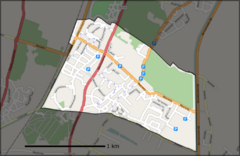Bennebroek facts for kids
Quick facts for kids
Bennebroek
|
|||
|---|---|---|---|
|
Village
|
|||

Bennebroek Dutch Reformed church
|
|||
|
|||
| Country | Netherlands | ||
| Province | North Holland | ||
| Municipality | Bloemendaal | ||
| Area | |||
| • Total | 1.81 km2 (0.70 sq mi) | ||
| Elevation | 1.4 m (4.6 ft) | ||
| Population
(2021)
|
|||
| • Total | 5,275 | ||
| • Density | 2,914/km2 (7,548/sq mi) | ||
| Time zone | UTC+1 (CET) | ||
| • Summer (DST) | UTC+2 (CEST) | ||
| Postal code |
2121
|
||
| Dialing code | 023 | ||
Bennebroek (Dutch pronunciation: [ˈbɛnəbruk]) is a small village in the northwest Netherlands. It's now part of a bigger area called Bloemendaal in North Holland. Before 2009, Bennebroek was actually the smallest municipality (like a small town area) in the whole Netherlands! It was only about 1.75 square kilometers big.
Contents
History of Bennebroek
Bennebroek likely started way back in the 1200s. Its early growth was all about harvesting 'peat,' which is like really old, dried-up plant material used for fuel.
How Bennebroek Became Independent
On May 28, 1653, Bennebroek became separate from the Heemstede area. A man named Adriaen Pauw became its first 'feudal lord,' which was like a powerful landowner. Back then, most people in Bennebroek made a living by raising animals or by transporting goods.
Changes Over Time
Later, growing beautiful bulb flowers became a very important business in Bennebroek. Think of all those famous Dutch tulips and hyacinths! Since the mid-1900s, Bennebroek has mostly become a place where people live and then travel to work in bigger nearby cities.
Joining Bloemendaal
On March 29, 2007, the local councils of Bennebroek and Bloemendaal decided to join together. This merger officially happened on January 1, 2009.
Fun Places to Visit in Bennebroek
Bennebroek has some cool spots that are worth checking out!
- Linnaeushof - This is a super famous park known as Europe's largest children's playground! It used to be a special garden for plants. In the 1700s, a famous scientist named Carl Linnaeus worked there as the main gardener. He even wrote an important book about plants called Hortus Cliffortianus while he was there.
- Hartekamp - This is a large estate, which is like a big property with a fancy house. Part of it is also in the nearby town of Heemstede. It has a huge public park that you can explore.
- Former Vogelenzang-Bennebroek railway station - This old train station was open from 1842 until 1944. It's a piece of history from when trains were a newer way to travel!
Gallery
See also
 In Spanish: Bennebroek para niños
In Spanish: Bennebroek para niños










